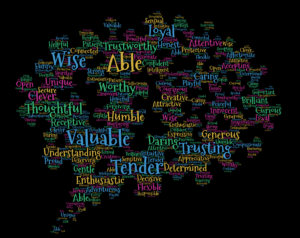 “If you can’t find the book you want, write it.” That’s exactly what Amy Pershing and Chevese Turner did when they wrote Binge Eating Disorder: The Journey to Recovery and Beyond, which will be released on August 10. This book uses personal stories, scientific research, and direct insight to “illuminate the experience of BED from the patient perspective while also exploring the disorder’s etiological roots and addressing the components of treatment that are necessary for long-term recovery” (Routledge). Both uniquely qualified to write the book, Amy and Chevese both have personal experience with binge eating disorder. Amy Pershing, founder of Bodywise™ binge eating disorder treatment program, works as clinical director of the Center for Eating Disorders in Ann Arbor, Michigan, and Chevese Turner, founder of the Binge Eating Disorder Association (BEDA), is “a passionate advocate and speaker working to eliminate eating disorders and weight stigma.”
“If you can’t find the book you want, write it.” That’s exactly what Amy Pershing and Chevese Turner did when they wrote Binge Eating Disorder: The Journey to Recovery and Beyond, which will be released on August 10. This book uses personal stories, scientific research, and direct insight to “illuminate the experience of BED from the patient perspective while also exploring the disorder’s etiological roots and addressing the components of treatment that are necessary for long-term recovery” (Routledge). Both uniquely qualified to write the book, Amy and Chevese both have personal experience with binge eating disorder. Amy Pershing, founder of Bodywise™ binge eating disorder treatment program, works as clinical director of the Center for Eating Disorders in Ann Arbor, Michigan, and Chevese Turner, founder of the Binge Eating Disorder Association (BEDA), is “a passionate advocate and speaker working to eliminate eating disorders and weight stigma.”
Swenson Book Development: What made you decide to write a book?
Amy T Pershing: For me, the primary motivation came from seeing so many clients with BED who had been in treatment that was ineffective, or even damaging, to their recovery. Many treatments for binge eating focus solely on the behavior of binge eating, and not on the underlying causes. For long-term healing to happen, we have to know the why; we have to understand the many ways binge eating makes sense in a person’s life. Additionally, people need to heal their relationship with their bodies not by “fixing” them with yet another attempt at weight loss, but by tending to them gently and compassionately. We also must consider how long-standing cultural and family messages about our bodies can serve to actually reinforce using food to soothe anxiety and shame. I did not know of a book to offer my clients that addressed recovery in this multifaceted way, so Chevese and I decided to write one.
Chevese Turner: As a professional BED advocate it is frustrating to have few resources to recommend to individuals, family members, and professionals who want to understand BED better. I want to be a resource to people, but not steer them in a direction that I know, from my own and others experiences, would actually do great harm. Most of the books on BED currently available conflate the disorder with obesity, recommend dieting/restriction as a treatment tool, and actually serve as a roadmap to entrenching the disorder. Each time I read one of these books, I am reminded that what drives these approaches is the exact mechanisms that help to create BED. To my way of thinking, it is past time to have a book that is not focused on BED as a problem of body size, but rather as to why it develops and how it serves its purpose. I wanted to write the book to help others learn compassion for themselves and maybe, just maybe, see how the disorder began as a strength, not a weakness. I hope that the small pieces I contributed help the reader understand that while all of our journey’s are unique, there are real human problems that underlie the disorder for every person. This book is a love letter to my own journey and I am privileged to have the opportunity to conceive of and write it with Amy Pershing. Amy and I have never had a therapeutic relationship, but the final steps of my recovery are a direct result of my proximity to her knowledge and wisdom. Sharing this with others is a dream come true.
 SBD: How has writing the book and bringing it into the world affected each of you?
SBD: How has writing the book and bringing it into the world affected each of you?
ATP: It definitely was emotional. I relived much of my own journey of recovery as I wrote, and remembered the risk it took to seek help. BED was not a defined eating disorder at that time; I was really in uncharted waters when I entered treatment in the mid-eighties. Thinking about how confused and alone I felt early on, and knowing my clients still often feel that too, is heartbreaking. I know how close I came to not getting help, and what destruction that would have meant to my life. I feel extraordinarily lucky to have taken this path.
CT: Like Amy, I feel very fortunate to have found treatment and support during a time that BED did not have a name and was dismissed as a problem of will-power. Going through my journals, recalling specific incidents, and the physical act of writing evoked many emotions and lots of tears. Many of the emotions and tears were sadness for a young Chevese who endured so much pain and shame, but even more came from a realization of just how close I came to not making it. Eating disorders are dangerous and deadly. Taking a look back in this way took me to an entirely new level of gratitude for my recovery and my life.
SBD: What has the process of co-authoring been like for you?
ATP: For my part, it has been delightful. We traded thoughts and ideas, but worked independently as well. Chevese’s story is so powerful, and she has so much integrity for her mission. She has been a very encouraging force for years in my working to develop this approach to BED treatment and trauma. We supported and kept each other going during the arduous process of writing a book, and I feel honored to count her among my dearest friends.
CT: When the idea for a book on BED came about, there was no question in my mind who I would want to work with. I had to trust that the pieces of the journey I would share would be alongside a clinical approach that had integrity, created hope, is inclusive, and did not create harm. There was not a moment that I doubted any of this with Amy, and that is the reason I wanted her to write the book. Our process allowed for the method of creating individually and together, which is what I expected and is the reason I knew Amy would be the perfect partner.
 SBD: What has been the greatest struggle you’ve overcome during the process of bringing about this book?
SBD: What has been the greatest struggle you’ve overcome during the process of bringing about this book?
ATP: I think for me the greatest struggle in this project has been a very personal one: seeing that old self-doubt emerge. Not unlike most of my clients, when I do something that really matters to me, my old critic voice still shows up, telling me that this book project won’t work, it’s not good enough, or I’m not adding anything new to the literature. These days though, after a lot of hard work in healing, I am able to see that critic energy for what it is: a part of me that developed those stories long ago, a voice that is actually trying to keep me safe by not letting me fail. I can meet that critic with compassion now (instead of a binge), and reassure myself that I will be okay. I feel a wonderful validation of this treatment approach when I realize how well it has served me in my own recovery. Without it, I would not have been able to take the risk to write this book.
CT: My greatest struggle was reconnecting to the past and moving on to relay the story and feelings, even when I was overwhelmed and, honestly, at times, triggered. It’s amazing how, even after years of treatment and therapy, rereading one’s own story can bring up so much grief. I did not realize how much grief remained around my journey when I began this process, and it propelled me to begin exploring the role it continues to play in my life. I’m thankful for the process and what it brought to me. It was an unexpected gift, albeit difficult at times.
SBD: This book has such a perfect harmony of personal experience, knowledge, and scientific research. What was your research process like?
ATP: I am tremendously grateful for the access I have to some amazing researchers in the field to help me navigate the latest findings. BED is still not adequately addressed in eating disorder research, and so there are still many gaps in our knowledge. I am also very fortunate to know a number of clinicians who are pioneers in this field, and who have been willing to share their expertise and stories of healing with us and our readers. This book has been, in so many ways, a group effort.
CT: Fortunately for me, I had very little academic research to complete. My research was in the journals I’ve kept through the years, speaking with family and friends to make sure I had my facts and memory correct, and interestingly enough, with music from the specific years I wanted to connect to. Music has a wonderful way of imprinting emotions, and I found it helpful to play certain albums from a time period as I was reading journals and recalling how I felt during times I was trying to capture in my writing.

SBD: Personally, what do each of you feel is, or would be, the greatest reward for your work on Binge Eating Disorder: The Journey to Recovery and Beyond?
ATP: For me, it would be for someone in treatment to feel a bit less alone in their struggle and more compassionate about their relationship with food and their body. I hope clinical readers come away with more understanding about the damage done to BED clients when trauma is not properly addressed, and how dieting and body shame are absolutely contraindicated for long-term healing. I’d be thrilled too if clinicians might take a closer look at their own body image, and challenge any shaming messages they may hear.
CT: It sounds cliche, but truly if just one person feels as if they can go on when they doubted it was possible, I will feel rewarded.
Binge Eating Disorder: The Journey to Recovery and Beyond will be released two weeks early on August 10, but you don’t have to wait until then to get your copy. You can pre-order right now on Amazon or Routledge.com to be one of the first to receive the book.

This sounds like a fantastic book and I wish Amy and Chevese all the success in the world. Everything they say makes perfect sense and I’ll certainly recommend to book to anyone who might come into my life with a binge eating disorder.